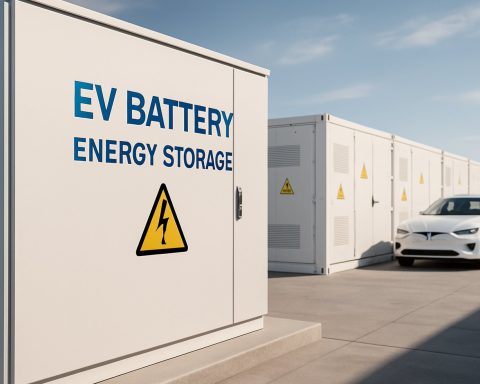- China’s EAST set a record by maintaining stable plasma for almost 18 minutes, marking significant progress in nuclear fusion technology.
- Fusion energy mimics star processes, offering a clean alternative to traditional nuclear power without hazardous waste.
- Hydrogen isotopes from water point to a sustainable energy source that could significantly cut down carbon emissions.
- Fusion breakthroughs have global implications, potentially reshaping energy policies and reducing reliance on fossil fuels.
- While promising, fusion development faces substantial technical and financial challenges that require significant investment.
- Success in harnessing fusion energy could spur new industries and drive environmental and economic strategies globally.
Dive into the groundbreaking world of nuclear fusion as China’s Experimental Advanced Superconducting Tokamak (EAST) shatters records, hinting at a future where clean energy reigns supreme. Often hailed as the “artificial sun,” EAST has astounded scientists by maintaining stable plasma for a jaw-dropping 17 minutes and 46 seconds—a leap forward that challenges the way we think about power sources.
Harnessing the Power of the Stars
Fusion energy mimics the celestial process powering the stars, heating atomic nuclei to temperatures exceeding 180 million degrees Fahrenheit. This marvel not only promises a cleaner alternative but also sidesteps the hazardous waste dilemma of traditional nuclear fission. With resources like hydrogen isotopes, drawn from water, this clean energy source could drastically reduce our carbon footprint.
Transforming Global Energy Landscapes
The implications of this feat reach far beyond China. Global enthusiasm for fusion technology is soaring, with projects like the International Thermonuclear Experimental Reactor (ITER) in France echoing this ambition on the international stage. If successful, fusion could transform energy policies worldwide, potentially diminishing geopolitical tensions and fostering economic equilibrium by reducing dependence on fossil fuels.
The Path Ahead: Challenges and Opportunities
Yet, the road to fusion-powered societies is fraught with technical and regulatory challenges. The immense costs and intricate developments are not for the faint-hearted. However, the potential to revolutionize energy production and create new industries is compelling, offering nations a chance to recalibrate their economic and environmental strategies.
As EAST and its counterparts continue to light the way, the prospect of a sustainable, abundant energy future feels increasingly tangible. This breakthrough is not only a testament to human ingenuity but also a beacon of hope for a world striving toward environmental harmony and sustainable growth. The fusion revolution is poised to redefine our energy landscape—it’s time to embrace the future!
China’s ‘Artificial Sun’ Breakthrough: A Glimpse Into the Energy Future
What are the latest trends in nuclear fusion research?
Nuclear fusion advances have recently seen dramatic progress, driven by various global initiatives like China’s EAST and the International Thermonuclear Experimental Reactor (ITER) in France. Key trends include:
1. Sustained Plasma Confinement: Researchers focus on maintaining plasma in a stable state for extended periods. EAST’s record-setting 17 minutes and 46 seconds is a significant milestone in this regard.
2. Innovative Magnetic Confinement Techniques: Advances in superconducting magnets, like those used in Tokamaks, are critical for stabilizing high-temperature plasmas and improving efficiency.
3. Public and Private Partnerships: Increased collaboration between governments and private tech companies speeds innovations and attracts significant investments. Companies like Helion Energy and Commonwealth Fusion Systems are at the forefront of fusion tech research.
For additional insights, check out the International Atomic Energy Agency’s website at IAEA.
How does nuclear fusion compare to traditional energy sources in terms of sustainability?
Nuclear fusion offers several sustainability advantages over traditional energy sources like coal, natural gas, and even nuclear fission:
– Minimal Environmental Impact: Fusion produces no carbon emissions, reducing the carbon footprint significantly compared to fossil fuels.
– Abundant Fuel Supply: The primary fuels for fusion, isotopes of hydrogen, are abundantly available from water, promoting long-term energy security.
– No Long-lived Radioactive Waste: Unlike fission, fusion reactions do not produce long-lived radioactive waste, addressing a significant environmental and safety concern.
Learn more about sustainable energy sources on the International Energy Agency’s main site: IEA.
What are the potential limitations and challenges of adopting fusion energy globally?
Though promising, fusion energy adoption faces notable technical and regulatory hurdles:
– High Costs: Developing commercially viable fusion energy systems requires substantial investments, often amounting to billions of dollars.
– Technical Complexity: Achieving and maintaining the extreme conditions necessary for fusion reactions is technically challenging and requires advanced materials and engineering solutions.
– Regulatory and Safety Concerns: Because fusion involves high-energy reactions, setting up comprehensive regulatory frameworks to ensure plant safety and efficiency is crucial.
Explore the economic and regulatory aspects of energy on the World Energy Council website: World Energy Council.
By embracing these innovations and addressing their challenges, nuclear fusion stands poised to redefine the future of global energy. From sustainability to geopolitical stability, the potential benefits are immense, making nuclear fusion an exciting field to watch.











